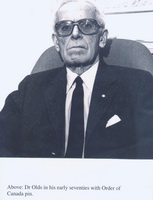 |
John Olds grew up in Connecticut, sailed on Long Island Sound, played polo at Yale, and went to medical school at Johns Hopkins. As a third year medical student, he travelled to an unheard of hospital in the obscure town of Twillingate in Newfoundland, at that time Great Britain’s oldest colony. The summer experience was to be used as an elective credit for students enrolled in the medical program at Hopkins. At a remote hospital, medical students could gain more hands-on experience and witness medicine as practiced outside the metropolitan medical centers. Most students came to Twillingate for the summer and then moved to larger communities or towns closer to home. However, Dr. Olds loved the maritime beauty of the place so much that, upon graduation in 1932, he returned, bringing his wife, Betty, whom he had met there in 1930 as a Hopkins nursing student. Initially, they decided to stay a year; the year turned into a lifetime.
|
|
When Dr. Olds arrived, Twillingate, and indeed the wider world, was in the depths of economic depression. Poverty and malnutrition were widespread. Even so, they settled in with the hopes of helping a community that was truly in need. When Dr. Parsons became ill and incapacitated and left Twillingate in 1934, Dr. Olds, at age 28, found himself chief physician and superintendent of the 90-bed hospital at Twillingate. At the time, many patients paid for medical services with quintals of fish or bushels of potatoes. Dr. Olds, realizing that such goods could not pay salaries or buy equipment, devised a plan known as the “blanket contract.” Each subscribing person paid 44 cents a year in exchange for full medical service at the hospital. The Blanket Contract was possibly the first such plan in North America – a forerunner of Medicare.
Since many of the neighbouring communities were hidden in remote coves, the only means of reaching the communities was by boat, horse-and-sled, or dog team. Faced with this reality, Dr. Olds developed a floating clinic using a 55-foot vessel named the Bonnie Nell. The ship’s after-cabin was prepared with an examining table, dentist’s chair and an X-ray machine. Each summer, a crew of three, plus a doctor, a nurse, and a medical student would make a complete circuit of the Bay providing medical services to the residents. In winter, Dr. Olds would travel to patients’ homes using two dogs that pulled him on skiis.
Armed with a well-equipped workshop, Dr. Olds constructed some of the tools he used during surgery – including a suture cutter, a steel reamer for hip joints, and a number of devices for holding incisions open during an operation. He also built some of his own designs such as a Bone Nibbler and Rib Shears. Many of his surgical tools are on display at the Twillingate Museum along with the skiis he used for winter travel.
During the last year-and-a-half of the Second World War, Dr. Olds was the only civilian doctor in Notre Dame Bay and was constantly on call. Going without sleep for days at a time, he became increasingly reliant on alcohol. Near the end of the War, he also contracted tuberculosis, for which there was still no treatment except rest and fresh air. In 1954, his wife, Betty, died. Some time after her death, he spent a year in a tuberculosis sanatorium where he overcame his ailments. Dr. Olds married again to a local nurse Stella Manuel and then, after her death, to a nurse from Nova Scotia, Gloria Chisholm. In 1966, Dr. Olds became a Canadian citizen and in 1974, joined with the Twillingate community in celebrating the 50th anniversary of the hospital. Dr. Olds was awarded the Order of Canada in Ottawa in April 1970. The Order of Canada Pin is now displayed at the Twillingate Museum. After a battle with cancer, Dr. John Olds died September 6th, 1985. His body was given to the medical school at Memorial University. His remains were later cremated and a memorial service was held at Twillingate.
|